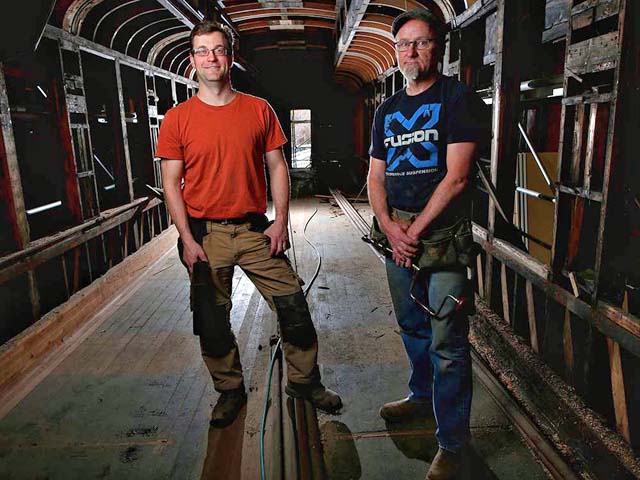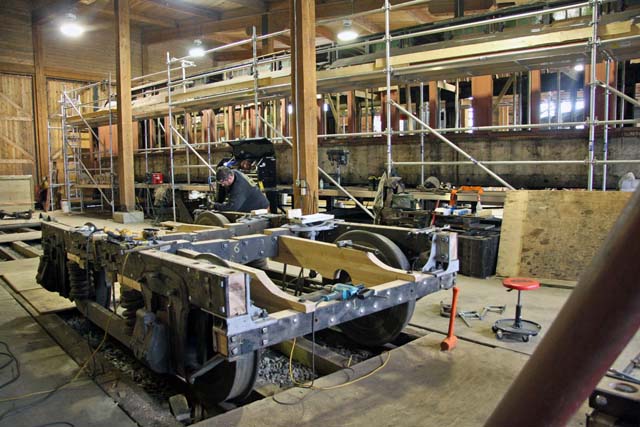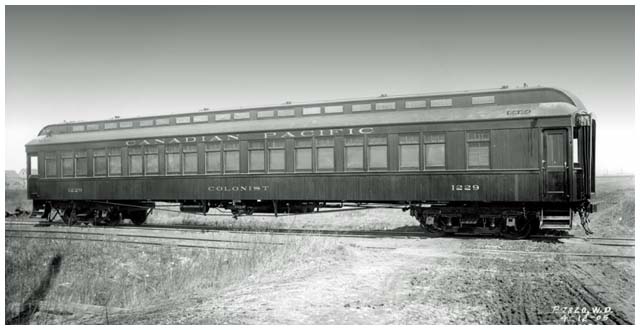 Calgary Alberta - Starting in the late 1800s, many thousands of immigrants travelled by Colonist cars
to their new homes in western Canada.
Calgary Alberta - Starting in the late 1800s, many thousands of immigrants travelled by Colonist cars
to their new homes in western Canada.
At the time, the cars were a common sight on the rails.
Now, only a handful exist.
Two carpenters at Heritage Park are busy restoring one of the original cars to its former glory.
Piece by tiny piece, a unique sliver of Canadian history, along with its accompanying heritage, is slowly regaining its true shape, serving as both a poignant
reminder of our past, and perhaps, as a true beacon of the future.
After 112 years, much of it spent in ceaseless toil carrying thousands of nervous, new, immigrants across the great northern prairie, car 1202 of that famous
Canadian Pacific Railway (CP) line was held together by little more than an occasional prayer.
Time, along with the simple inertia that comes from finally being allowed to stand in one place, also took its toll on this passenger rail car that most
recently had been housed at Heritage Park in Calgary.
The long lengths of fir timber that provided the structure for this carriage, one of only two true colonist cars still surviving in some vague semblance of
original form, were rotting.
Also in disrepair were the windows, out of which so many scared yet excited youngsters would see the strange, unending, northern landscape.
The 40 wooden berths, where double that number once sat through seven uncomfortable days and nights, as the steam locomotive pulling car 1202 moved ever
westward, were equally damaged.
She, because this was a vessel giving comfort, though it moved across land, and therefore deserves such feminine acknowledgement, was almost beyond
repair.
But to some, "almost" is not a call of despair, rather, it's a call to arms and ultimately to action.
That's why, almost 12 months ago, Calgary carpenters Mike Willie and Doug Zech found themselves staring at the rotting hulk of car 1202, wondering, "What
the heck do we do now?"
Their task was to bring her back to life, as part of the celebration for Canada's 150th birthday.
The rail car had sat in Calgary's Ogden rail yards for years until CP decided to hand it over to Heritage Park, speculating that perhaps the country's largest
historical village could find some use for it.
That was back in 1965 and, apart from a brief stint as a period set piece in a historical TV documentary, and an even less glamorous role as a makeshift
concession stand at the park, car 1202 was judged too far gone to be of much use.
Not any longer.
Every day she gets closer to that original shape and style that made the colonist cars the very lifeblood of cross-prairie travel for up to three million
newcomers in the early 20th century.
Families from far and wide would arrive in Halifax or Montreal and then board these cars for up to seven days of travel to a new and intimidating home in
strange places called Manitoba, Saskatchewan, and Alberta.
Aboard was one stove, one sink, and one washroom.
The passengers spent a challenging week among new, close, neighbours from all parts of Europe, bound together by the dream of a new life in this huge,
unyielding land.
While the amenities on car 1202 were few, its bones were strong.

She was so well crafted that for Zech, hired by Heritage Park on a two-year contract, coming to grips with this restoration also restored his own love of
woodworking.
"I rediscovered techniques that got me into woodworking in the first place," Zech says.
"I saw the way nowadays everything is increasingly cut by machine and then assembled by a person, which means so many cabinet makers become simply box
makers. But then with this car, well, it is all traditional wood, and every single piece is joined together in some way. It was why I got into woodwork in the
first place, to do traditional joinery work, and this is simply like a huge piece of furniture," he says.
His buddy in this painstaking labour of love, one not expected to be complete for at least another year, is Mike Willie.
He was already on staff at the park, as chief carpenter.
Still, this is special.
"This really is the most unique project I've had the privilege to work on," Willie says.
"It is one of a kind. The level of detail put into the car originally, the precision of the joints, the accuracy of manufacture all the way through, and
the complexity of the structure are things you don't see now.
"Today, the tolerances (allowable variations in construction) are a sixth of an inch or more. It's amazing to find this car, over a hundred-years-old,
where the tolerance would have been fractions of that, and all built by hand," Willie says.
"To see how they overcame the obstacles of making the car so solid and safe is simply amazing. When we got the skin off, so to speak, and saw the angle
braces down to the metal hooks to adjust the tension in the frame, then when you see all those little things, you realize, this is built right. It is
remarkable."
As a restoration project, car 1202 must be put back together as close as possible to its original state, using original materials.

However, sometimes that simply cannot be done.
"The fir for the frame, at the time, was available in gigantic lengths," notes Zech.
"This original beam is 70 feet long, but rarely are there trees now that big, you would have to go into old-growth Douglas fir forests to cut down
something that length. Protesters would be very upset. Trees just don't get that big now, so we have to replace it in sections."
With the wooden lighting fixtures, there was an even greater problem.
None had survived, so old-time craftsmanship made room for the new-fangled art of 3D printing.
By carefully following images from ancient photos, exact replicas were produced layer by layer and will be installed in the carriage, the ultimate construction
blend of future and past.
Like his co-worker, Zech is amazed at the skill of those old-time craftsmen at Montreal's Angus Shops.
"Everything is joined together with some kind of mechanical wood joinery," he says.
"This wasn't then screwed together, they didn't need screws. The men that built this were master craftsmen. Even after 112 years, you can't put a piece of
paper between the joints."
The future of car 1202 is undoubtedly in safe hands.
But its legacy goes beyond the bygone skills of master craftsmen.
It's also a legacy of the immigrants that would ultimately forge this country.
Heritage Park CEO Alida Visbach understands its place in history.
Her parents made that cross-prairie trip, after arriving from the Netherlands.
"This means a lot to me personally because I am first generation Canadian," she says.
"My parents came to Pier 21 in Halifax and then they travelled on one of these cars.
"But, also the importance of this story right now to Canadians is incredible," she adds.
"We are a country of immigrants, and I think that is why this story is so important today. We want to show that in a tangible way. It makes it real for
everybody and reminds us what it means to be Canadian."
By the summer of next year, thanks to Willie and Zech, car 1202 will be reborn and on permanent display.
She deserves her rest and due admiration at Heritage Park.
Yet her legacy, and what that means to would-be future Canadian immigrants contemplating their own daunting journey westward, rolls onward.
Lit as a beacon.
Car 1202 faces another long year of restoration but the story of which she is part will be celebrated nationally this summer, starting at Calgary's Heritage
Park.
Launching at the park on 1 Jul 2017 a replica section of the car will be the backdrop for a stage play, showcasing the trials and tribulations of those who
made that fraught rail journey across the Canadian Prairie.
Calgary's Quest Theatre actors will play individuals thrown together on a Colonist car in the early part of the 20th century.
While taking in the play, Calgarians will also be able to glimpse the on-going restoration work on the original car 1202.
After a few weeks in Calgary, the exhibit, along with the local actors, will travel to Halifax's Pier 21 to perform.
The ensemble and a related exhibit gradually make their way westward, ending up in Vancouver at the end of 2017.
"We will have the visible restoration of car 1202 for the public to see and also, on 1 Jul 2017 we will be cutting the ribbon on an exhibit that we will
later take across the country, replicating the sense and feel of this Colonist car and the story it tells," said Park CEO Alida Visbach.
The project has been made possible with the support of The Bank of Montreal, the Alberta government, the City of Calgary, and local philanthropist Joan
Snyder.
Chris Nelson.
Learn more about Heritage Park and their Canadian Pacific Railway exhibits in this article.
provisions in Section 29 of the Canadian
Copyright Modernization Act.


